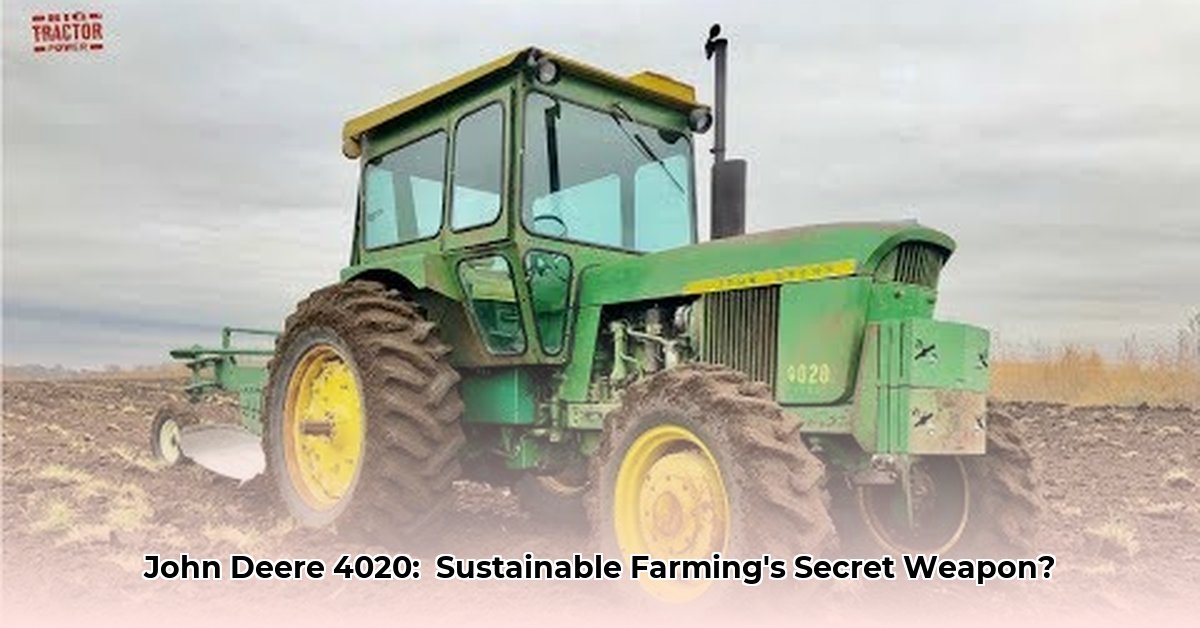
The John Deere 4020, particularly the cab-equipped version, represents a pivotal moment in agricultural mechanization. Produced between 1963 and 1972, over 184,000 units were sold, signifying a widespread shift towards mechanized farming. This article analyzes the tractor's impact on sustainable agriculture, examining both its positive and negative contributions within the context of technological advancements. For more information on smaller John Deere tractors, see this page.
A Powerful Machine, But at What Environmental Cost?
The 4020’s robust engine, boasting 83.79 drawbar horsepower and 95.83 PTO horsepower, revolutionized farm productivity. It offered gasoline, diesel, and liquid propane gas engine options. However, fuel efficiency wasn't a primary design consideration compared to modern tractors. This raises a critical question: how can we balance the need for powerful agricultural machinery with environmental stewardship?
Examining the 4020's Sustainability Footprint
While the 4020's durability reduced the need for frequent replacements, minimizing waste in one aspect, its fuel consumption and emissions were significantly higher than those of modern tractors. This highlights the importance of considering a product's entire lifecycle – from manufacturing to disposal – when assessing its environmental impact. The sheer volume of 4020s produced and eventually discarded undoubtedly contributed to environmental challenges.
Comparative Analysis: 4020 vs. Modern Tractors
The following table compares the John Deere 4020 to modern tractors, revealing significant advancements in sustainability-focused design:
| Feature | John Deere 4020 (1963-1972) | Modern Tractors |
|---|---|---|
| Power (horsepower) | 83.79 (drawbar), 95.83 (PTO) | Significantly higher |
| Fuel Efficiency | Relatively low | Significantly improved |
| Emissions | Higher | Significantly reduced |
| Technology | Basic | Advanced precision farming (GPS-guided systems, variable rate technology) |
| Overall Sustainability | Mixed (longevity vs. emissions) | More focused on sustainability (reduced emissions, fuel efficiency, reduced chemical use) |
This comparison underscores the evolution of agricultural machinery towards greater sustainability. While the 4020's longevity was a significant advantage, its substantial fuel consumption and emissions contrast sharply with modern standards. Further research, including comprehensive life-cycle assessments (LCAs), is needed to fully quantify the total environmental impact.
Unanswered Questions and Future Research Directions
Several key areas require further investigation to fully understand the 4020's long-term environmental impact:
- Precise Fuel Consumption Data: Detailed fuel consumption data across various tasks, soil types, and crops are needed. This requires analyzing field data from operational use and accounting for varying conditions.
- Manufacturing and Disposal Analysis: A comprehensive LCA comparing the environmental footprint of a 4020's manufacturing and disposal with that of modern tractors is crucial.
- Retrofitting Potential: Could modifications improve the 4020's sustainability? This could involve engine upgrades or integrating more efficient farming techniques.
Addressing these questions will provide valuable insights into past practices and informs future developments in sustainable agricultural technology.
Fuel Efficiency: A Critical Comparative Analysis
The 4020's fuel efficiency varied greatly depending on the engine type. Gasoline models proved notably less efficient than their diesel counterparts. This difference has significant implications for comparing its operational costs to modern tractors.
Assessing Fuel Efficiency Differences
A systematic comparison between the 4020 and modern tractors requires a multi-step process:
- Specify Tractor Details: Identify the 4020 model (gasoline or diesel) and horsepower.
- Locate Comparable Modern Tractors: Find modern tractors with similar horsepower ratings and intended applications.
- Gather Fuel Consumption Data: Consult manufacturer specifications, owner manuals, or online resources for fuel consumption rates (gallons/hour or liters/hour) under comparable operating conditions.
- Factor in Operational Variables: Account for differences in terrain, workload, and operator skill, as these significantly influence fuel usage.
- Calculate Cost Per Hour: Determine fuel costs per unit volume and multiply by the hourly consumption rate to compare the operational expenses.
This comparison, though complex, provides a more accurate reflection than simply comparing horsepower alone. It’s important to acknowledge that field data and real-world conditions may still lead to variations.
Conclusion: A Legacy of Innovation and Challenges
The John Deere 4020 remains a landmark tractor, symbolizing a pivotal shift in agricultural practices. Its ruggedness and power are undeniable, but its fuel efficiency and emissions highlight the ongoing evolution of sustainable agriculture. Understanding this legacy helps us to appreciate the continuous improvement needed to balance productivity with environmental responsibility. Future research must focus on detailed comparative studies, using life-cycle assessments, to fully evaluate the 4020's complete environmental impact.